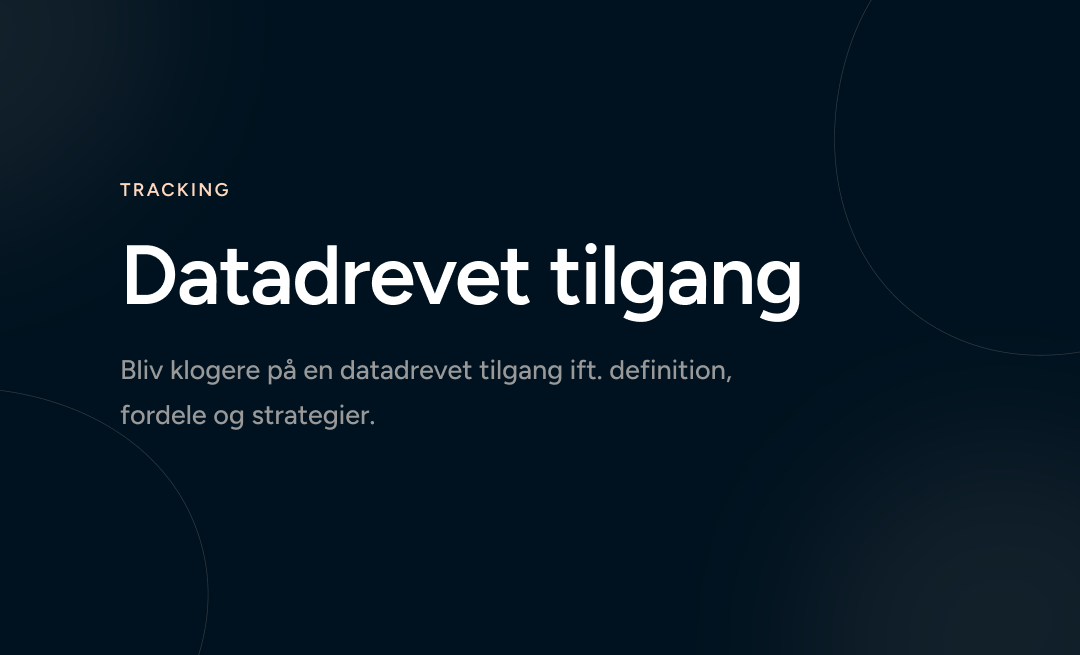Tracking
2. maj 2025
Datadrevet tilgang | Definition, fordele, strategier

Når du først har hørt udtrykket “data-drevet”, synes det at dukke op overalt – fra lederskab, organisationer, innovation, virksomhedskultur, sundhed og økonomi til webudvikling, marketing, design og software. Det er nærmest blevet et buzzword i den digitale verden, noget der får folks arbejde til at lyde mere high-tech og avanceret, end det måske virkelig er. Det er som et magisk ord, der øjeblikkeligt får ethvert projekt til at virke smartere, bedre eller mere innovativt.
Lad os bryde det ned og kaste lys over, hvad det virkelig betyder at være “data-drevet”, hvordan det fungerer, og hvad fordelene er. Derefter kan du tage et skridt tilbage, og se om dine projekter eller organisation virkelig er data-drevne og få nogle indsigter i, hvordan man adopterer et ægte data-drevet mindset for at holde dig et skridt foran.
Hvad betyder det at være datadrevet? Hvordan adskiller det sig fra det konventionelle?
At være data-drevet betyder at have en strategisk tilgang, der udnytter kraften i forbrugerdata til at guide udviklingsprocessen. Det involverer indsamling, analyse og anvendelse af data for at opnå værdifuld indsigt i brugeradfærd, præferencer og behov. Dette gør det muligt for virksomheder at skabe en mere personlig og brugercentreret oplevelse.
Tag webudvikling for eksempel. I fortiden var det for det meste baseret på gætværk, mavefornemmelser og generel markedsforskning. Men nu, takket være data videnskab og analyse, er det blevet en mere eksakt videnskab. Data-drevet webudvikling bruger data, som den vejledende stjerne, der hjælper med at træffe beslutninger gennem hele udviklingsprocessen.
9 trin til en datadrevet tilgang
Datadrevet webudvikling er en systematisk proces, der omfatter indsamling, analyse og anvendelse af brugerdata. Her er en forenklet gennemgang af processen:
- Fastlæg klare mål og målsætninger
Før du begynder på et webudviklingsprojekt, er det afgørende at fastlægge klare mål og målsætninger. Hvad er slutspillet her? Er du ude på at øge trafikken på websitet, øge konverteringsraterne eller øge brugerengagementet? - Dataindsamling
Det første trin er at samle relevante data om din målgruppe. Disse oplysninger kan høstes gennem forskellige kanaler som hjemmesider, sociale medieplatforme, kundeundersøgelser og købshistorik. Her anvendes værktøjer som Google Analytics, heatmaps, og brugerundersøgelser for at indsamle både kvantitative og kvalitative indsigter. - Dataanalyse
Efter dataindsamlingen er det vigtigt at dissekere disse data for at udtrække værdifulde indsigter. Avancerede analytiske værktøjer og teknikker hjælper med at spotte mønstre, tendenser og korrelationer i dataene, hvilket baner vejen for datadrevne beslutninger. - Segmentering
De indsigter, der er opnået fra dataanalysen, udstyrer marketingfolk til at opdele deres publikum i distinkte grupper baseret på demografi, adfærd og præferencer. - Personaliser brugeroplevelsen
En af de fremtrædende fordele ved datadrevet webudvikling er evnen til at skræddersy brugeroplevelser. Ved at udnytte brugerdata kan virksomheder tilpasse indhold, tilbud og interaktioner for individuelle brugere, hvilket forbedrer engagement og tilfredshed. Dette muliggør udformningen af personaliserede marketingbeskeder og oplevelser, finjusteret til de specifikke behov og interesser for hver segment. - Optimering og testning
Datadrevet webudvikling er en tilbagevendende proces, der kræver løbende optimering for succes. Forskellige strategier, budskaber og kanaler testes, med resultater, der nøje overvåges for at foretage datainformerede justeringer og optimere ydeevnen. A/B-testning er en potent teknik i datadrevet webudvikling. Ved at sammenligne to versioner af en webside eller element, kan virksomheder afgøre, hvilken variation der er mest effektiv, hvilket giver dem mulighed for at træffe datainformerede beslutninger. - Evaluering og måling
Hjørnestenen i datadrevet webudvikling er at vurdere virkningen af webudviklingsindsatsen. KPI’er er etableret for at spore succesen af kampagner, og målinger som konverteringsrater, customer aquisition cost (CAC) og kundens livstidsværdi undersøges for at vurdere ydeevnen. - Iterative forbedringer
Datadrevet webudvikling er en cyklisk proces. Virksomheder bør konstant overvåge og analysere brugerdata, identificere områder til forbedring og implementere datadrevne justeringer for at forbedre websitets ydeevne.
Hvad er fordelene ved datadrevne processer?
At adoptere en datadrevet tilgang kan være en total game-changer for virksomheder, der sætter dem op til reel succes i den digitale verden.
Her er nogle få nøglefordele:
- Forbedret beslutningstagning
Data-drevne indsigter giver et faktisk grundlag for beslutningstagning, minimere risici og usikkerheder. - Personaliseret kundoplevelse
Ved at forstå kundens præferencer gennem data, kan virksomheder tilbyde en skræddersyet oplevelse, forbedre tilfredshed og loyalitet. - Forbedrede produkter og tjenester
Dataanalyse hjælper med at identificere kundebehov, hvilket muliggør udvikling af produkter og tjenester, der opfylder disse behov. - Operationel effektivitet
Data-drevet beslutningstagning giver virksomheder mulighed for at optimere deres forsyningskæde og lagerstyring. Ved at analysere data om kundedemand, købsmønstre og leveringstider, kan virksomheder sikre, at de har de rigtige produkter på lager på det rigtige tidspunkt. Dette reducerer lageromkostninger, minimerer udsolgte varer og forbedrer den samlede operationelle effektivitet. - Konkurrencemæssig fordel
I et konkurrencedygtigt marked kan data-drevne strategier give virksomheder en betydelig fordel, hjælpe dem med at holde sig foran. Virksomheder kan identificere fremvoksende trends og forbrugernes krav. Dette gør det muligt for dem at udvikle og lancere produkter, der imødekommer deres målgruppes ændrede behov. Derudover kan data hjælpe virksomheder med at identificere uudnyttede markedssegmenter og udvikle målrettede marketingstrategier for at nå nye kunder. - Identifikation af muligheder
Dataanalyse giver virksomheder de nødvendige indsigter til at identificere nye muligheder, udvikle innovative produkter og tjenester og ekspandere til nye markeder. - Optimeret prissætning
Data giver virksomheder mulighed for at finjustere deres prissætningsstrategier. Ved at analysere prisdata kan virksomheder bestemme de optimale prispoint, der maksimerer rentabiliteten, samtidig med at de forbliver konkurrencedygtige på markedet. Dette muliggør mere effektive prissætningsstrategier og øget omsætning. - Øgede konverteringsrater
Data-drevne indsigter hjælper med at identificere forbedringsområder i webdesign, indhold og brugerflow. Ved at optimere disse elementer, kan virksomheder opleve højere konverteringsrater og øget salg.
Hvad er de almindelige udfordringer forbundet med den datadrevne tilgang?
At omfavne en datadrevet tilgang er måske ikke en spadseretur i parken for virksomheder, på trods af dens mange fordele. Udfordringerne er mange, startende med datakendskab – eller snarere manglen på det. Det er ikke ualmindeligt at finde medarbejdere, der klør sig i nakken, når de står over for opgaven med dataanalyse og fortolkning. Denne kompetencekløft kan sætte en kæp i hjulet for den smidige overtagelse af en datadrevet kultur.
Så er der det bjerg af data, som virksomheder skal håndtere. Uden de rigtige teknologiske værktøjer til at indsamle, gemme og analysere disse data, er det som at prøve at finde en nål i en høstak. Virksomheder kan have svært ved at udvinde nogen nyttige indsigter fra deres data, hvis de ikke har den rette infrastruktur og analytiske kapabiliteter.
Og lad os ikke glemme databeskyttelse og sikkerhed. I denne digitale tidsalder indsamler virksomheder mere persondata end nogensinde før. Men med store data kommer også stort ansvar. Virksomheder skal sikre, at de overholder reglerne, når det kommer til databeskyttelsesregler. Ethvert fejltrin kan forårsage mere end blot en irettesættelse; det kan føre til alvorlig skade på omdømmet og juridiske konsekvenser.
Men udfordringerne stopper ikke der. At opretholde datakvaliteten er en konstant kamp. Dårlig kvalitet eller unøjagtige data kan føre til vildledende indsigter og dårlige beslutninger. For ikke at nævne den herkuliske opgave det er at integrere data fra forskellige kilder og i forskellige formater.
At skifte til en datadrevet tilgang handler ikke kun om at adoptere nye teknologier; det handler også om en betydelig kulturel ændring inden for organisationen. At overbevise alle om at komme ombord kan føles som at forsøge at flytte bjerge. Og kirsebærret på toppen? At holde trit med de konstant ændrende databeskyttelses- og privatlivsregler. Det er en kompleks og udfordrende opgave, men en der ikke kan ignoreres.
Hvordan gør du dit firma mere datadrevet?
For at implementere en datadrevet tankegang i din organisation med succes, overvej følgende strategier:
- Invester i datafærdigheder
Giv træning og ressourcer til at forbedre dataforståelsen blandt medarbejdere. Dette inkluderer at lære grundlæggende dataanalysefærdigheder, fremme datadrevet tænkning og give adgang til værktøjer og teknologier, der letter dataanalyse. - Etabler en datadrevet kultur
Fremme en kultur, der værdsætter data og evidensbaseret beslutningstagning. Opfordrer medarbejdere til at bruge data i deres daglige arbejde, belønne datadrevne præstationer og fremme en kultur for kontinuerlig læring og forbedring. - Udvikle en datastrategi
Definer klare mål og formål for dine datainitiativer. Bestem hvilke data du skal indsamle, hvordan det vil blive analyseret, og hvordan disse indsigter vil blive brugt til at drive beslutningstagning. Udvikle en køreplan for implementering af din datastrategi og tildel ressourcer i overensstemmelse hermed. - Sikre datakvalitet
Etabler datastyringsprocesser for at sikre data nøjagtighed, konsistens og integritet. Implementer data validering og rensningsprocedurer for at minimere fejl og sikre data pålidelighed. - Samarbejd på tværs af afdelinger
Bryd siloer ned og opfordre til tværfagligt samarbejde. Datadrevet beslutningstagning skal involvere input fra forskellige afdelinger og interessenter for at sikre en holistisk udsigt over virksomheden.
At omfavne en datadrevet tankegang er afgørende for virksomheder, der ønsker at opnå bæredygtig vækst og succes. Selvom der kan være udfordringer ved at adoptere en datadrevet tilgang, kan implementering af de rigtige strategier hjælpe med at overvinde disse forhindringer. Fremtiden for datadrevet beslutningstagning har stort potentiale, med fremskridt inden for teknologi og analyser, der åbner op for nye muligheder for virksomheder. Ved at omfavne en datadrevet tankegang kan virksomheder positionere sig for langvarig succes i det konstant skiftende forretningslandskab.




